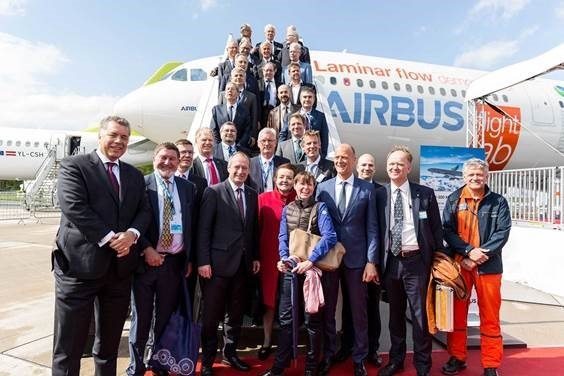
Airbus presents ‘Flight Lab’ BLADE test aircraft to EU Clean Sky partners at ILA
Airbus, which is showcasing its “Flight Lab” BLADE demonstrator aircraft for the first time at a major air show, has signed an accord with representatives of the numerous stakeholders to not only mark the joint success of bringing this unique programme to fruition, but also affirm their desire to build on this programme in the European framework of Clean Sky. The stakeholders present together with Airbus CEO Tom Enders at the ceremony included members of the European Parliament, the European Commission, the German Government, European Member States and industrial partners across Europe.
The BLADE project, which stands for “Breakthrough Laminar Aircraft Demonstrator in Europe”, is part of the first phase of Clean Sky – a 1.6 billion Euro programme which has been running since 2008. BLADE has been tasked with assessing the feasibility of introducing laminar flow wing technology on a large airliner. It aims to improve aviation’s ecological footprint, bringing with it a 10 percent aircraft drag reduction and up to five percent lower CO2 emissions. Airbus worked with a team of more than 20 key partners* and around 500 contributors from all over Europe. Moreover, due to its size and complexity, this project was only possible thanks to the European Research initiative Clean Sky.
In September 2017 Airbus’ A340 laminar-flow Flight Lab test demonstrator aircraft (A340-300 MSN001) made its successful maiden flight and since then has been engaged in successful testing to explore the wing’s characteristics in flight. The test aircraft is the first in the world to combine a transonic laminar wing profile with a true internal primary structure.
On the outside the aircraft is fitted with two representative transonic laminar outer-wings, while inside the cabin there is a highly complex specialist flight-test-instrumentation (FTI) station. The extensive modifications to the A340-300 test-bed aircraft took place during the course of a 16-month working party in Tarbes, France, with the support of the numerous industrial partners across Europe. In terms of the testing technology, notable ‘firsts’ included the use of infrared cameras to monitor the laminar flow transition points and the acoustic generator which measures the influence of acoustics on laminarity. Another first is the innovative reflectometry system which measures overall deformation in real-time during flight. To date the Flight Lab has performed 66 flight hours. Flights will continue until 2019, dedicated to exploring the influencing factors on laminarity.
